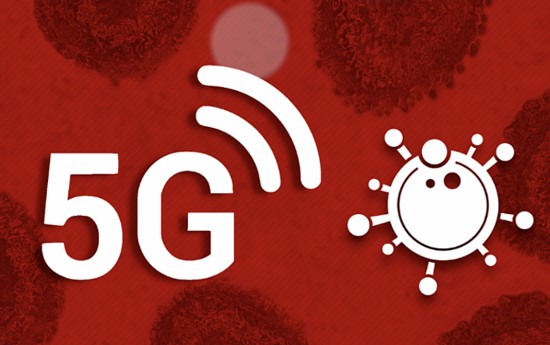Wireless telecommunication which uses radiowaves has been blamed for so many current challenges. In 2019, one of the most read pieces I wrote for this site, discussed and debunked the link between new radio bandwidths and global warming.
Now, wireless technology is linked to COVID-19’s emergence in articles appearing on the Internet. One marked double fact-checked that appears on the website News Punch, claims a peer-reviewed scientific study has been published linking the deployment of 5G networks with COVID-19. It states that the study conclusively proves the link between wireless technology and the spread of viruses and illness. The article it points to is a study appearing on the National Institute of Health (NIH) website. In reading the paper, however, nowhere in the content is there a definitive link, just supposition, descriptions of symptoms, and stating they are common to wireless network exposure and the coronavirus. The claim that this paper has been peer reviewed bares inspection.
Technology and Perceived Danger: Some is Real Some is Not
You can list technologies we have accepted for use in our world that have potential downsides. Too many X-rays can cause radiation damage. Taking too many over-the-counter or prescription medicines can induce harmful medical conditions. Driving cars contributes to air pollution that can exacerbate conditions like asthma. But affirming a direct 5G connection to COVID-19 is neither conclusively proven nor even close to reality.
What sites like News Punch will not do is follow up and publish a retraction when it turns out they are wrong. For example, the article describing conclusive evidence also quotes another study as corroborative. But although it tells you that the second study was published on the NIH website, linking 5G deployment to the appearance of coronavirus in skin cells, it doesn’t note that the latter was recently retracted. No doubt, the study with “definitive proof” will soon go the retraction route based on its weak science and supposition rather than correlation or causation.
News Punch in the same article names Dr. Anthony Fauci as one of the villains suppressing “the truth” about 5G and COVID-19. Then it adds to the “facts” of its argument linking bee honey production to 5G deployment. And finally, it accuses Dr. Fauci of knowing for the past 15 years that hydroxychloroquine cures coronaviruses (which it does not ) of which COVID-19 is one. How prescient of the good doctor to have this knowledge and how evil of him not to share it.
The Peer-Review Conundrum and Credentialed Websites
COVID-19 isn’t brought on by 5G wireless deployment despite what serial producers of fake news and misinformation spew on the Internet. Just because studies appear on websites with good credentials doesn’t necessarily mean that the information they are providing is correct. That’s because peer-reviewed may not reflect what is actually taking place prior to an article being accepted for publication.
Today, peer-reviewed doesn’t have the same cachet as it has had in the past. This is happening because of the explosion in the number of scientific papers being published. Back in 2016, Nature published an article that stated scientific paper publishing was increasing at a rate of 8 to 9% per year and that this had been ongoing for several decades. In 2018, another Nature article noted that thousands of scientists were becoming hyper-prolific in publishing research at rates of one paper every five days. They were doing this because authorship was linked to scholarship which was linked to tenure in academia.
Another ongoing change to scientific publishing is the emergence of preprints. These are articles that get put on a server for general viewing by the scientific community. They have yet to be peer-reviewed. A study done in 2020, noted that more than 200,000 articles had appeared in the scientific literature on the subject of COVID-19. Many never made it beyond pre-print. And even those that went through a peer-review process, and got published ended up upon further review being retracted. This trend in COVID-19 articles continued through 2021 and 2022 and no doubt will in 2023. Many of these papers will appear briefly on legitimate peer-reviewed journal sites and then be retracted. Why this is happening relates to the volume increase and the lack of enough qualified reviewers capable of reading through this deluge of information. Many studies can get past a reviewer with no more than a look at the abstract. Considering the quality of writing in so many scientific papers these days, this shouldn’t be a surprise. Volume plus indecipherable prose is making peer review problematic.
But for those who are serial distributors of misinformation, the publishing explosion of weak science is an opportunity to cherry-pick content to conform to a fake news agenda and ideology. And because sites like News Punch continue to publish articles like these gathering an audience that is steeped in the world of conspiracy theories, its content is grist for their mill.
When the Internet began, and in the early days of social media sites, I naively thought that with barriers to universal communication and knowledge sharing disappearing, we would witness a levelling of the playing field where all nations and people would no longer be disadvantaged. But what I forgot was human nature’s dark side always rises to the occasion when presented with a new means to disseminate lies. It is our penchant to find the dark side combined with the Internet that makes a site like Breitbart be seen by some as legitimate when compared to legacy news organizations that publish verifiable facts and not fakery with a political agenda.
If you find this subject of interest, you may find an article published in the February 7th edition of USA Today written by Nate Trela worth reading.









